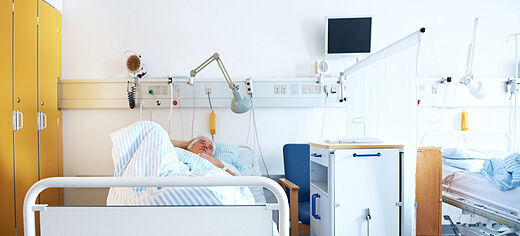
The chance of infection in some NHS wards varies dramatically according to whether the nurses leave the windows open.
A University of Leeds-led team studied airflow in a “Nightingale” ward—the classic NHS ward that traditionally accommodated two rows of up to 30 beds—using tracer gases to simulate how airborne infections spread.
They found ventilation in the ward was generally good when windows were left open, keeping the danger of airborne infection low. But risks increased fourfold when the windows were closed.
Lead investigator Dr Cath Noakes, from the University of Leeds’ School of Civil Engineering, said: “These wards are still in operation and, although they have often been subdivided into smaller areas with 6-8 beds, their ventilation and structure is still fundamentally the same.
“We found that when you operate them properly, with natural ventilation from the windows, they perform as the Department of Health would like them to. But we also asked what happens in the winter if the windows are closed?
“There is a big push on energy in buildings and it worries many of us who work on indoor air quality. People are being told to seal up their buildings to save energy. We found, if you do that without alternative ventilation systems, you could be increasing the airborne infection risk significantly,” Dr Noakes said.
“Some of these wards were designed by the Victorians, and our results show that they knew what they were doing. But there is a danger that we could be adapting our buildings to improve efficiency without thinking how it might affect patients,” Dr Noakes said.
The study, conducted jointly with the Bradford Teaching Hospitals NHS Foundation Trust in a disused ward at St. Luke’s Hospital in Bradford in summer 2010, used carbon dioxide as a tracer gas to represent potentially infectious exhaled breath.

A computer simulation of air movements in a “Nightingale” ward. The image shows air flowing from a set of windows on one side of the building toward windows opposite. The colours are used to distinguish the different flows from each window.
Carbon dioxide detectors were positioned where beds might be placed in a working ward and the gas was released by popping carbon-dioxide filled balloons.
“By measuring the concentration of the gas over time, we were able to quantify the exposure at each bed and therefore the potential risk to a patient in that bed,” said Laura Pickin, one of the members of the research team. “We were also able to use the same data to measure the overall ventilation rate in the ward.”
The Department of Health recommends that a ward should be ventilated at six air changes per hour, which means replacing the equivalent volume of air in the room six times every hour. “When the windows were left open in the ward, we recorded ventilation rates that were either satisfactory or better than the NHS standard” said Dr Carl Gilkeson, a Research Fellow who worked on the project. “When the windows were closed, the measured exposure to infection was typically four times higher, equivalent to a ventilation rate of only 1.5 air changes an hour.”
The researchers found mechanical ventilation systems to be an effective alternative to natural ventilation. The installation of small extractor fans, similar to a domestic bathroom ventilator, beside each bed had a marked positive effect on ventilation, reducing risks to a comparable level to opening the windows.
The study also looked at the effect of partitioning an old “Nightingale” ward to create single bays, a common solution to the problems of privacy posed by traditional designs. Although partitioning slightly increased risks to people in the immediate vicinity of an infected patient, it reduced risks elsewhere in the ward. The findings indicate that it is feasible to partition wards to create a better patient environment without significantly increasing the overall risk of infection.
“These wards still exist and in the current economic environment they are likely to remain for some time. However, we have shown that they can be modified and that their ventilation can be good if they are managed correctly,” Dr Noakes said. “Introducing simple mechanical ventilation to supplement the airflow in the winter, could be an effective approach to ensuring good ventilation year-round, without the energy costs of a full air conditioning system”.
Co-author Dr Miller Camargo-Valero, Lecturer in Water and Environmental Engineering at the University of Leeds, said: “These simple, low-energy and low-cost solutions could also be of significant benefit for hospitals in the developing world, particularly in countries where airborne diseases such as tuberculosis are a major concern.”
Measurement of Ventilation and Airborne Infection Risk in Large Naturally Ventilated Hospital Wards” is published in the Building and Environment Journal. The research was funded by the Engineering and Physical Sciences Research Council (EPSRC).
Further information:
Dr Cath Noakes is available for interview on request.
Contact: Chris Bunting, Press Officer, University of Leeds; phone +44 113 343 2049 or email c.j.bunting@leeds.ac.uk
The full paper: C. A. Gilkeson, M. A. Camargo-Valero, L. E. Pickin, C. J. Noakes, “Measurement of Ventilation and Airborne Infection Risk in Large Naturally Ventilated Hospital Wards” Building and Environment (2013; DOI: 10.1016/j.buildenv.2013.03.006) is available online at http://www.sciencedirect.com/science/article/pii/S0360132313000851.